





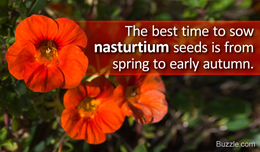 Nasturtiums should not be confused with the plants that belong to Nasturtium genus and Brassicaceae (cabbage) family. They belong to the Tropaeolum genus; nasturtium is their common name.Gardening enthusiasts, especially those who are more interested in flowering plants, would most willingly include nasturtiums in their flower gardens. This flowering plant produces umbrella-shaped foliage and vibrant-colored flowers. If you get a chance to look at the vibrant shades of the nasturtium flowers, you will know why this plant has been naturalized in several regions of the United States. Technically, this plant is a perennial, but it is treated as an annual. It thrives in frost-free regions. In fact, it is considered to be a weed in New Zealand and Hawaii due to its vigorous growth. The varieties that have a trailing habit can be used for accenting the garden walls or trellis. Several hybrid varieties are also available, with some varieties producing vibrant single or double flowers.There's more to this plant than its beautiful flowers; its leaves and flowers are edible. Tender leaves of nasturtium have a peppery taste, and can be used in salads, soups, risottos, etc. Nasturtiums are easy to care for, and can be directly sown into the ground. They can also be grown in pots.Nasturtium Plant Information
Nasturtiums should not be confused with the plants that belong to Nasturtium genus and Brassicaceae (cabbage) family. They belong to the Tropaeolum genus; nasturtium is their common name.Gardening enthusiasts, especially those who are more interested in flowering plants, would most willingly include nasturtiums in their flower gardens. This flowering plant produces umbrella-shaped foliage and vibrant-colored flowers. If you get a chance to look at the vibrant shades of the nasturtium flowers, you will know why this plant has been naturalized in several regions of the United States. Technically, this plant is a perennial, but it is treated as an annual. It thrives in frost-free regions. In fact, it is considered to be a weed in New Zealand and Hawaii due to its vigorous growth. The varieties that have a trailing habit can be used for accenting the garden walls or trellis. Several hybrid varieties are also available, with some varieties producing vibrant single or double flowers.There's more to this plant than its beautiful flowers; its leaves and flowers are edible. Tender leaves of nasturtium have a peppery taste, and can be used in salads, soups, risottos, etc. Nasturtiums are easy to care for, and can be directly sown into the ground. They can also be grown in pots.Nasturtium Plant Information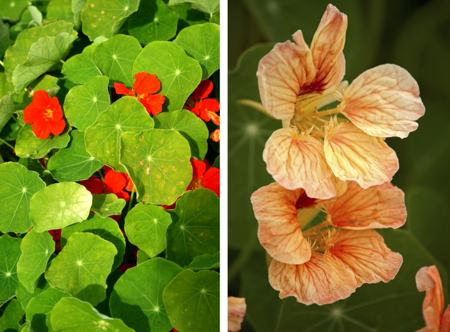 Red and Pale Yellow Nasturtium Flowers✦ Genus: Tropaeolum
Red and Pale Yellow Nasturtium Flowers✦ Genus: Tropaeolum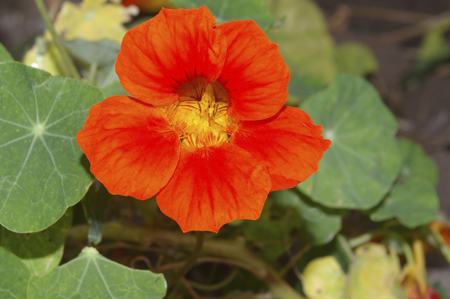 Red Nasturtium Flower
Red Nasturtium Flower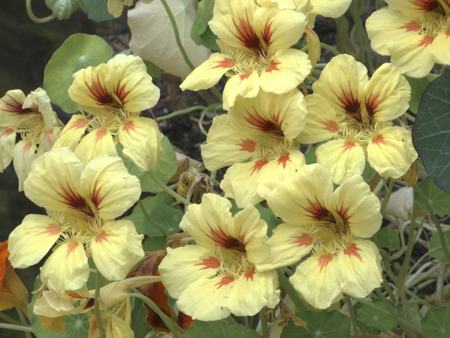 Pale Yellow Nasturtium Flowers
Pale Yellow Nasturtium Flowers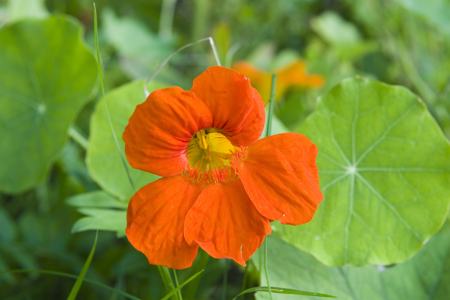 Orange Nasturtium Flower
Orange Nasturtium Flower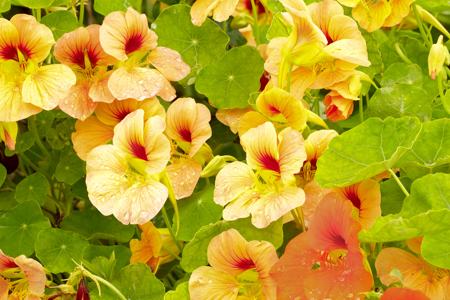 Yellow Nasturtium Flower
Yellow Nasturtium Flower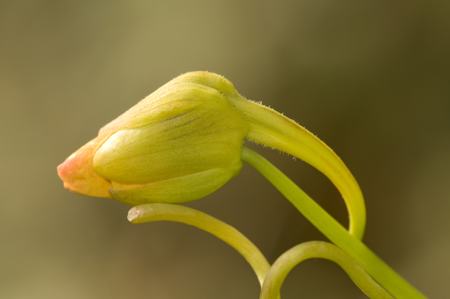 Nasturtium Bud
Nasturtium Bud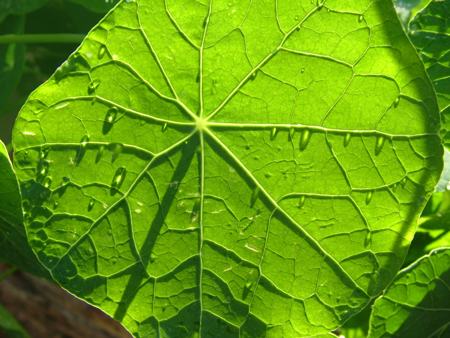 Closeup of the Underside of a Nasturtium LeafHow to Grow NasturtiumWell-drained soil is indispensable for the growth of this plant. Here are the other conditions that you need to provide for ensuring proper growth of nasturtiums.Growing Nasturtiums from Seeds
Closeup of the Underside of a Nasturtium LeafHow to Grow NasturtiumWell-drained soil is indispensable for the growth of this plant. Here are the other conditions that you need to provide for ensuring proper growth of nasturtiums.Growing Nasturtiums from Seeds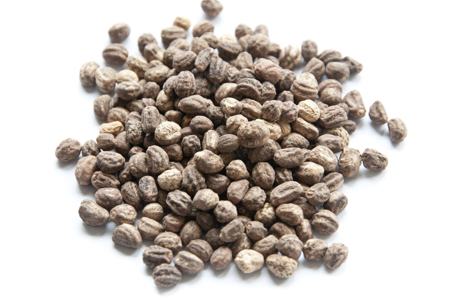 Nasturtium SeedsYou can easily grow this plant from seeds. The seeds are quite large, and can be handled by children. If you are buying the seeds from a garden center, check the details on the packet.In regions that are warm, the best time to sow the seeds is from spring to early autumn. On the other hand, in colder regions, the seeds must be sown in spring, when the danger of frost has passed.This plant is not very needy, when it comes to soil requirements. If you are planting the seeds in flower beds, rake the soil and dig holes measuring an inch in depth. It is advisable to sow the seeds in rows, ensuring that the rows are placed at least 12 inches apart.The process of germination takes up to 15 days. Before planting, you could also soak the seeds overnight. It might have a good effect on the germination process. The optimal range of soil temperature for germination is 55-65°F. From the time of sowing the seeds, till the development of seedlings, ensure that surface of the soil stays moist.If you are sowing the seed in a pot, then take care while transplanting. At times, the seedlings or the root might get damaged while transplanting. To avoid this, you could use a biodegradable peat or coir pot. While transplanting, you can directly put the pot into the ground.Light RequirementsThis plant does best in full sun. It will thrive if the planting site receives at least 6 hours of sun. It can also tolerate light shade, but you will not be able to see profuse flowering if you put it in a place that doesn't receive ample sunlight. If you live in a hot region, it is advisable to protect it from the scorching afternoon sun. If the plant is kept indoors, find a place where it will not be exposed to strong winds or cold drafts.Soil Type and FertilizerThis plant does best in sandy soil. If you apply manure or nitrogen-rich fertilizers often, you will see a spurt in the growth of leaves. It must be noted that amending the soil will cause a substantial reduction in the number of flowers. So, all you need to do is plant it in a nutrient-rich soil, and avoid feeding the plant during the growing season. As most gardening enthusiasts are more interested in vibrant-colored flowers than foliage, it is advisable to refrain from excessive application of fertilizer.Watering
Nasturtium SeedsYou can easily grow this plant from seeds. The seeds are quite large, and can be handled by children. If you are buying the seeds from a garden center, check the details on the packet.In regions that are warm, the best time to sow the seeds is from spring to early autumn. On the other hand, in colder regions, the seeds must be sown in spring, when the danger of frost has passed.This plant is not very needy, when it comes to soil requirements. If you are planting the seeds in flower beds, rake the soil and dig holes measuring an inch in depth. It is advisable to sow the seeds in rows, ensuring that the rows are placed at least 12 inches apart.The process of germination takes up to 15 days. Before planting, you could also soak the seeds overnight. It might have a good effect on the germination process. The optimal range of soil temperature for germination is 55-65°F. From the time of sowing the seeds, till the development of seedlings, ensure that surface of the soil stays moist.If you are sowing the seed in a pot, then take care while transplanting. At times, the seedlings or the root might get damaged while transplanting. To avoid this, you could use a biodegradable peat or coir pot. While transplanting, you can directly put the pot into the ground.Light RequirementsThis plant does best in full sun. It will thrive if the planting site receives at least 6 hours of sun. It can also tolerate light shade, but you will not be able to see profuse flowering if you put it in a place that doesn't receive ample sunlight. If you live in a hot region, it is advisable to protect it from the scorching afternoon sun. If the plant is kept indoors, find a place where it will not be exposed to strong winds or cold drafts.Soil Type and FertilizerThis plant does best in sandy soil. If you apply manure or nitrogen-rich fertilizers often, you will see a spurt in the growth of leaves. It must be noted that amending the soil will cause a substantial reduction in the number of flowers. So, all you need to do is plant it in a nutrient-rich soil, and avoid feeding the plant during the growing season. As most gardening enthusiasts are more interested in vibrant-colored flowers than foliage, it is advisable to refrain from excessive application of fertilizer.Watering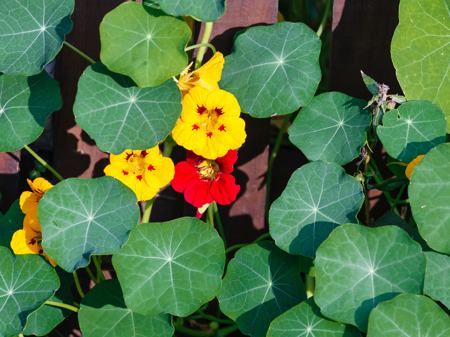 Yellowing of Nasturtium LeavesThough the leaves might turn yellow due to seasonal changes, it could also be a sign of excessive watering. Nasturtiums don't need a lot of water. If you live in a region where there's a lot of rainfall during summer, you might not need to water the plant. If you don't live in such a region, deep watering a couple of times in a week would suffice. Before watering, check the soil by putting a stick or your finger in the soil. Water the plant when the soil is dry. Also, water the plant in the morning.DiseasesMold or fungus can have an adverse effect on the plant. Nasturtiums are known to be susceptible to an aphid infestation. Aphids might feed on the foliage, thereby damaging them. In order to prevent an infestation, you could physically remove them, or spray the leaves with water. You could also wash the leaves, along with their underside, with a soapy solution, and wipe them.On a concluding note, nasturtium plants are simple to care for. To add to that, they make excellent companion plants. Pests such as cucumber beetles and squash vine borers don't come near the plant due to the peppery taste of the foliage. If you are growing pumpkins, squash, and cucumbers in your garden, it would be a good idea to keep the nasturtium plant next to them. Not only will your garden be a sight to watch in the flowering season, you can also use the leaves and petals for adding a peppery flavor to dishes.
Yellowing of Nasturtium LeavesThough the leaves might turn yellow due to seasonal changes, it could also be a sign of excessive watering. Nasturtiums don't need a lot of water. If you live in a region where there's a lot of rainfall during summer, you might not need to water the plant. If you don't live in such a region, deep watering a couple of times in a week would suffice. Before watering, check the soil by putting a stick or your finger in the soil. Water the plant when the soil is dry. Also, water the plant in the morning.DiseasesMold or fungus can have an adverse effect on the plant. Nasturtiums are known to be susceptible to an aphid infestation. Aphids might feed on the foliage, thereby damaging them. In order to prevent an infestation, you could physically remove them, or spray the leaves with water. You could also wash the leaves, along with their underside, with a soapy solution, and wipe them.On a concluding note, nasturtium plants are simple to care for. To add to that, they make excellent companion plants. Pests such as cucumber beetles and squash vine borers don't come near the plant due to the peppery taste of the foliage. If you are growing pumpkins, squash, and cucumbers in your garden, it would be a good idea to keep the nasturtium plant next to them. Not only will your garden be a sight to watch in the flowering season, you can also use the leaves and petals for adding a peppery flavor to dishes.
Coneflowers: How to Plant, Grow, and Care for Coneflowers
Cosmos: How to Plant, Grow, and Care for Cosmos
Impatiens: How to Plant, Grow, and Care for Impatiens
Petunias: How to Plant, Grow, and Care for Petunias
Yarrow: How to Plant, Grow, and Care for Yarrow
Copyright © www.100flowers.win Botanic Garden All Rights Reserved